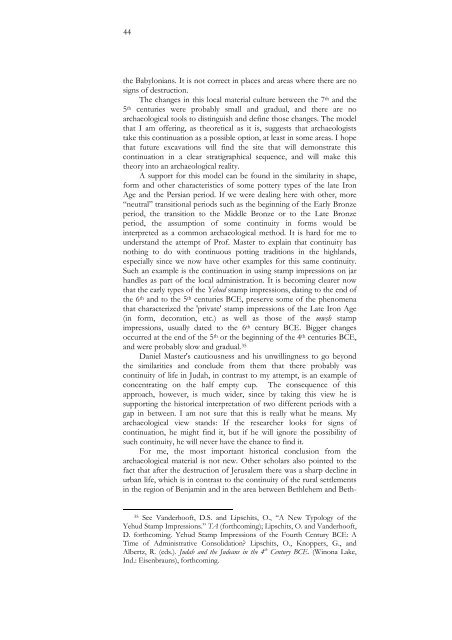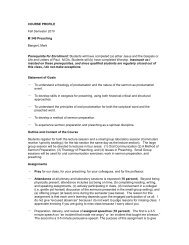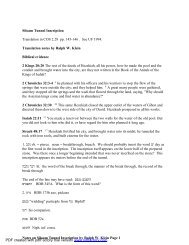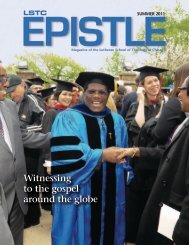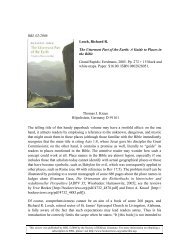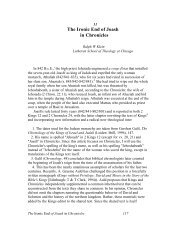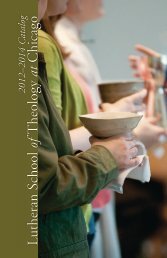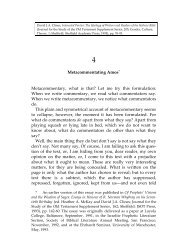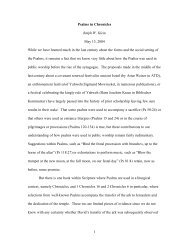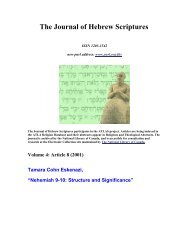Download this PDF file - University of Alberta - Journal Hosting
Download this PDF file - University of Alberta - Journal Hosting
Download this PDF file - University of Alberta - Journal Hosting
You also want an ePaper? Increase the reach of your titles
YUMPU automatically turns print PDFs into web optimized ePapers that Google loves.
44JOURNAL OF HEBREW SCRIPTURESthe Babylonians. It is not correct in places and areas where there are nosigns <strong>of</strong> destruction.The changes in <strong>this</strong> local material culture between the 7 th and the5 th centuries were probably small and gradual, and there are noarchaeological tools to distinguish and define those changes. The modelthat I am <strong>of</strong>fering, as theoretical as it is, suggests that archaeologiststake <strong>this</strong> continuation as a possible option, at least in some areas. I hopethat future excavations will find the site that will demonstrate <strong>this</strong>continuation in a clear stratigraphical sequence, and will make <strong>this</strong>theory into an archaeological reality.A support for <strong>this</strong> model can be found in the similarity in shape,form and other characteristics <strong>of</strong> some pottery types <strong>of</strong> the late IronAge and the Persian period. If we were dealing here with other, more“neutral” transitional periods such as the beginning <strong>of</strong> the Early Bronzeperiod, the transition to the Middle Bronze or to the Late Bronzeperiod, the assumption <strong>of</strong> some continuity in forms would beinterpreted as a common archaeological method. It is hard for me tounderstand the attempt <strong>of</strong> Pr<strong>of</strong>. Master to explain that continuity hasnothing to do with continuous potting traditions in the highlands,especially since we now have other examples for <strong>this</strong> same continuity.Such an example is the continuation in using stamp impressions on jarhandles as part <strong>of</strong> the local administration. It is becoming clearer nowthat the early types <strong>of</strong> the Yehud stamp impressions, dating to the end <strong>of</strong>the 6 th and to the 5 th centuries BCE, preserve some <strong>of</strong> the phenomenathat characterized the 'private' stamp impressions <strong>of</strong> the Late Iron Age(in form, decoration, etc.) as well as those <strong>of</strong> the mwṣh stampimpressions, usually dated to the 6 th century BCE. Bigger changesoccurred at the end <strong>of</strong> the 5 th or the beginning <strong>of</strong> the 4 th centuries BCE,and were probably slow and gradual. 35Daniel Master's cautiousness and his unwillingness to go beyondthe similarities and conclude from them that there probably wascontinuity <strong>of</strong> life in Judah, in contrast to my attempt, is an example <strong>of</strong>concentrating on the half empty cup. The consequence <strong>of</strong> <strong>this</strong>approach, however, is much wider, since by taking <strong>this</strong> view he issupporting the historical interpretation <strong>of</strong> two different periods with agap in between. I am not sure that <strong>this</strong> is really what he means. Myarchaeological view stands: If the researcher looks for signs <strong>of</strong>continuation, he might find it, but if he will ignore the possibility <strong>of</strong>such continuity, he will never have the chance to find it.For me, the most important historical conclusion from thearchaeological material is not new. Other scholars also pointed to thefact that after the destruction <strong>of</strong> Jerusalem there was a sharp decline inurban life, which is in contrast to the continuity <strong>of</strong> the rural settlementsin the region <strong>of</strong> Benjamin and in the area between Bethlehem and Beth-35 See Vanderho<strong>of</strong>t, D.S. and Lipschits, O., “A New Typology <strong>of</strong> theYehud Stamp Impressions.” TA (forthcoming); Lipschits, O. and Vanderho<strong>of</strong>t,D. forthcoming. Yehud Stamp Impressions <strong>of</strong> the Fourth Century BCE: ATime <strong>of</strong> Administrative Consolidation? Lipschits, O., Knoppers, G., andAlbertz, R. (eds.). Judah and the Judeans in the 4 th Century BCE. (Winona Lake,Ind.: Eisenbrauns), forthcoming.


